ASAP - Abbreviation for "as soon as possible."
asbestos - A fibrous, fire-proof mineral used in 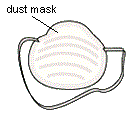 gloves,
aprons,
gloves,
aprons, and mats
for its heat-resistance. Contact with asbestos has been found
to present a much greater health hazard
than previously thought, and should never be used in schools.
Find substitutes. If you must work with it, wear a protective
mask at minimum.
ascender - The part of the lowercase letters that project above the middle guideline, as in b, d, f, h, k, l, and t.
ashlar - In architecture, squared, hewn stone laid in regular courses.
Also see masonry.
aspect ratio - This is the ratio (proportion) of a shape's width to its height. Computer and video monitors (television screens) can be proportioned for widescreen material (16:9) or for traditional TV viewing (4:3).
| displays | aspect ratios |
| standart TV and older movies | 4:3 or 1.33:1 |
| US digital TV (HDTV) | 16:9 or 1.78:1 |
| standard widescreen | 1.85:1 |
| anamorphic widescreen (Panavision or Cinemascope) | 2.35:1 |
Also see Golden Mean.
asphaltum - In etching, a liquid that is used on plate as a soft ground, and on the backs of plates to protect them from the mordant. In lithography, asphaltum is used to chemically process the drawing. Also, an old color which was found to be destructive to painting.
assemblage sculpture - A three-dimensional composition made of various materials such as found objects, paper, wood, and textiles.
Examples:
Jean Arp (born "Hans Arp") (French, 1886-1966), Trousse d'un Da, 1920-1921, assemblage of driftwood nailed onto wood with some remains of old painting, 38.7 x 27 x 4.5 cm, Georges Pompidou Center, Paris.

Raoul Hausmann (Austrian, 1886-1971), Mechanical Head [or, The Spirit of Our Time],
1919, assemblage: the head of a
mannequin in wood,
with diverse objects attached to it (including a leather
pocketbook, a collapsing aluminum
cup, brass and cardboard
labels, part of a telescope, a pipe, white cardboard with the
figure 22, a part of a dressmaker's measure, a watch gear-wheel,
a printing roller), 12 5/8 x 9 inches (32.5 x 21 x 20 cm), Centre
Georges Pompidou, Paris. See Dada.
Kurt Schwitters (German, 1887-1948; in Norway 1937-40; in England 1940-48, Picture with Basket Ring (Bild mit Korbring), 1938, assemblage: wood, rattan ring, paper, iron and steel nails on wood, 15 x 11 3/4 inches (38.1 x 29.8 cm), Museum of Modern Art, NY. (A fine point: Someone at the Museum of Modern Art describes this as an "assemblage," and this may be more appropriate than calling it a relief construction or a collage. Is it less of a collage because its components are joined by nails than by adhesives, or because its support is wood rather than paper? From this photo of it, Picture with Basket Ring resembles what might just as appropriately be described as a collage. If these terms overlap, how much do they?!)

Alberto Magnelli (Italian, 1888-1971), Still Life, 1914, assemblage:
plaster, glass and terra
cotta, 56.5 x 54 x 56.5 cm, Georges Pompidou Center, Paris.
See still life.
Louise Nevelson (American, 1899-1988), Royal Tide V, l961, found wood assemblage sculpture. See feminist art.
Arman (Armand Fernandez) (American, born France, 1928-), Condition of Woman I, 1960, mixed media, metal, wood and glass, 192.0 x 46.2 x 32.0 cm, Tate Modern, London.

Lucas Samaras (American, born Greece, 1936-),
Box, 1963, mixed
media, 35.0 x 25.5 x 38.0 cm, Tate Gallery, London. See texture.

Lucas Samaras, Box #61, 1967, mixed
media, 34.3 x 29.9 x 48.3 cm, Tate Gallery, London. Inside
the lid of this box is a photo of the artist's face. He has stuck
pins at regular intervals along the edge
of his cheek, mustache, and mouth. Because Samaras' father was
a shoemaker, and his aunt had a dress shop, pins have particularly
great significance to him. He remarked that, "The pin is
to an extent a part of the family." Samaras said, "The
pins are lines, marks and dots, they create a net pattern which
gives a strange illusion."
Also see bricolage, collage, construction, Constructivism, marouflage, Rube Goldberg, and sculpture.
assessment - Analyzing and determining the the nature and quality of students' achievement through means appropriate to the subject. "Assessment" has come to us from the Latin word assidere, which means, “to sit with.” That is very apt indeed. In art education there are many instruments used in assessment: rubrics, check-lists, games, and tests are among them. Contrary to the opinions of some, a "testicle" is not, nor ever has been, a humorous question on a test.
Also see art therapy, bias, effort, examination, interesting, masterpiece, monitor, Praxis, and webucation.
Assyrian art - See Mesopotamian art.
 ASTM
International (the former
American Society for Testing and Materials (ASTM)) - ASTM
International is a voluntary standards development organization — a source for technical standards for materials, products, systems,
and services, in the areas of design, manufacturing and trade.
ASTM
International (the former
American Society for Testing and Materials (ASTM)) - ASTM
International is a voluntary standards development organization — a source for technical standards for materials, products, systems,
and services, in the areas of design, manufacturing and trade.
ASTM International, originally known as the American Society for Testing and Materials (ASTM), was formed in 1898, when a group of engineers and scientists got together to address frequent rail brakes in the railroad industry. Their work led to standardization on the steel used in rail construction, ultimately improving railroad safety.
Since then, ASTM has played a leading role in addressing the standardization needs around the world, making products and services safer, better and more cost-effective. Standards developed at ASTM are the work of over 30,000 ASTM members, technical experts representing producers, users, consumers, government and academia from over 100 countries. Their mark is often found on art materials and equipment. ASTM has set standards on color and appearance measurement. For more information about this organization and its standards, visit the Web site of ASTM International.
Many manufactured art and craft materials carry a label stating "Conforms to ASTM D-4236" indicates that the product conforms to the labeling standards of the Hazardous Art Materials Act (HAMA), which was signed into US law on November 18, 1988. If the product is non-toxic, then no warning needs to be included on the label. However, if the product is found to carry acute or chronic health hazards, the information on the label must alert the consumer to those hazards. The part of this law which is of greatest importance here is the Labeling of Hazardous Art Materials Act (LHAMA). The law requires art material labels to (a) carry a warning statement identifying chronic health hazards, (b) list the ingredients causing those hazards, and (c) provide directions for safe use of the product. The phrase, "Conforms to ASTM D 4236", is required as evidence that the guidelines of the standard were followed in the labeling of the product. The evaluation is to be conducted by a board-certified toxicologist, and the product must be reevaluated periodically, at least every five years. Another key piece of information to be found on the label, as directed by the standard, is a source for additional information. This can take the form of a toll free phone number that is reachable 24 hours per day, or directions to contact a poison control center network. Under the Labeling of Hazardous Art Materials Act, it became a requirement for chronically hazardous products to carry the phone number of a person responsible for placing the product on the market. The Consumer Product Safety Commission (CPSC) is the US's federal agency charged with enforcing HAMA.
Also see AP, Art & Creative Materials Institute (ACMI), caustic, CL, ergonomics, flammable, fumigation, hazardous, Material Safety Data Sheet (MSDS), Occupational Safety and Health Administration (OSHA), poison, safety, science and art, toxic, and volatile.
Asturian art - A ninth century Gothic style with Moorish derivation used in Spanish churches in the Asturias region.
Also see architecture and Islamic art.
Asuka - A period in Japanese art history from 552 - 645, which is the first part of Japan's Early or Classical period of Buddhist art. The Asuka period was preceded by the Kofun perod (about CE 200 - 500), and was followed by the Hakuho or Early Nara Period (645-710).
Example of Asuka art:

Japan, Asuka period, Seated Buddha, height 27.9 cm, Asuka
Period, 7th century. Japanese authorities have designated this
piece from the Horyuji Treasure an "Important Cultural Property."
![]()

Japan, Asuka period, Standing Bosatsu (Bodhisattva), 7th century.
See Bodhisattva.
asymmetry, asymmetrical balance - Asymmetry is when one side of a composition does not reflect the design of the other. Asymmetrical balance is the kind of balance (one of the principles of art) in which the parts of a design are organized so that one side differs from the other without destroying that composition's overall harmony. Consequently, when an asymmetrical design is disturbingly off balance, the result is disharmony. Also known as informal balance, asymmetry is the opposite of symmetry.
Asymmetry is the type of balance most characteristically found in Japanese art. In Japanese, this intentional unevenness is called "hacho."
(pr. ay-SIH-mə-tree)
Asymmetrical balance can be observed in these pictures:

Jan (or Johannes) Vermeer (Dutch, Delft,
1632-1675), Young Woman with a Water Jug, c. 1660-67,
oil on canvas,
18 x 16 inches (45.7 x 40.6 cm), Metropolitan Museum of Art,
NY. (If you click on the title of this painting, on the Met's
page you can enlarge any
detail.) See Baroque.
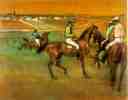
Edgar Degas (French, 1834-1917), Race Horses, 1885-1888, pastel on panel,
11 7/8 x 16 inches, Philadelphia Museum of Art. See Impressionism.
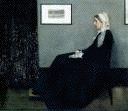
James
Abbott McNeill Whistler American, 1834-1903), Arrangement in Grey and Black No. 1: Portrait
of the Artist's Mother, 1871, oil
on canvas, 4 feet 8 3/4 x
5 feet 3 3/4 inches, Musée d'Orsay, Paris, France. With
planes and shapes
flattened, and color
muted, Whistler's portrait demonstrates
his devotion to aestheticism
and art for art's sake.
Accordingly, Whistler prefered to describe this paintings as
an arrangement — much as music is an arrangement of
pure forms — making him a precursor
to abstract art. See abstraction
and rectangle.

Paul Strand (American, 1890-1976), Abstraction, Twin Lakes, Connecticut,
1916, depicted: Connecticut, United States of America, silver
and platinum print, 32.8 x 24.4 cm (12 15/16 x 9 5/8 inches),
Metropolitan Museum of Art, NY. See photography.
Sol LeWitt (American, 1928-2007), Asymmetrical Pyramid, 1986, watercolor, gouache, and pencil on paper, 22 1/2 x 30 1/4 inches (57 x 77 cm), Museum of Modern Art, NY.
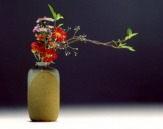
This
asymmetrical work of ikebana
(Japanese
art of flower arrangement) is typical of a style
focused on standing flowers, or rikka.
atectonic - In sculpture and architecture, describes shapes or forms that tend to reach out into open space.
Also see boss, projection, and rugosity.
atelier - French. An artist's or an artisan's studio; a workshop. Sometimes refers to a studio where an artist trains for his profession.
Also see bottega.
atlant, atlantid, or atlas - A muscular male nude, either carved or painted, acting as a column or pillar, carrying an architrave or other architectural element. This is the male counterpart of a caryatid. Named after Atlas, the Titan (giant) who in Greek mythology was condemned to carry the earth and the heavens on his shoulders. The atlant, employed in both Roman and Greek architecture, was revived in Baroque architecture and painting. The Romans called such figures telamones. The plural form of atlant is atlantes.
Example:
Michelangelo Buonarroti (Italian, 1475-1564), The Bearded Slave, also known as Atlant, 1527-28, marble, height 8 feet 4 3/4 inches (277 cm), width 2 feet 4 3/4 inches, depth 3 feet 1/2 inch, Galleria dell'Accademia, Florence. This allegorical figure is one of several intended for the tomb of Pope Julius II in Rome.
Also see post and lintel, Greek art, Roman art, and statue.
atmospheric perspective - See aerial perspective.
atrium - In architecture, an inner courtyard, often colonnaded or given a glass ceiling, and often at the entrance of a public building.
(pr. AY-tree-əm)
Example:
![]()

![]()
![]()
In an ancient Pompeiian home, its atrium and impluvium.
Also see impluvium.
attention - Concentration of thought upon a subject. A close or careful observing or listening. Focusing one's ability or power to concentrate mentally. Giving observant consideration. Artists refer to attentive seeing as gazing, and give much consideration to the gaze of the audience for their works. Artists anticipate that most attention will be drawn to the focal point of a work, but that the quality of a viewer's attention depend upon such factors as his/her consciousness, knowledge, and interest, along with such other factors as the context of that work's exhibition.
Factors influencing attention:
Attention is utterly essential for learning. When demanded by a teacher, attention means "Stop, Look and Listen." Stop working, talking, moving, and put things down. Look toward the teacher or the student who's been called upon. Listen means: think about what you see and hear, and speak only when called upon. When a student needs to let a teacher know he needs attention (excepting emergencies), the appropriate means is to raise a hand when the speaker has stopped. Raising a hand does not guarantee that a student will be called upon, although teachers should try to share time as much as possible and appropriate.
Quote:
Also see achievement, déjà vu, effort, fluorescent colors, gestalt, meaning, memory, motivation, obsession, perception, subliminal message or subliminal advertising, and theater.
attitude - A mental position (feeling or emotion) concerning a fact or a state; a state of mind; a point of view or an outlook. Attitudes are relatively enduring views on people, behavior, events, or things. Attitudes are expected to change as a result of experience, in contrast to personality, which, as another mental construct, is much less apt to alter over time.
An attitude can also be a position in which a body is placed; an arrangement of body parts; a body's posture, gesture, or pose. Because a body's position and movement can express feelings and ideas apart from oral and facial expressions, it is said to communicate in "body language."
Quote:
Also see achievement, artistic temperament, bias, brainstorming, effort, empathy, expression, inspiration, irony, meaning, memory, model, motivation, muse, nuance, obsession, positive, praise, and sentiment.
attribute - An object often associated with a person, character, or office. Examples are the crown jewels of a king, the trident of Neptune, and the caduceus of a physician.
(pr. AT-trə-byoot)
Artworks in which attributes are important elements:
![]()
Johan Gregor van der Schardt (Dutch, 1530-
about 1580), Mercury, Bologna, Italy, 1570-1580, bronze, height
45 1/4 inches (115 cm), J. Paul Getty Museum, Malibu, CA. Van
der Schardt has given Mercury several attributes that signify
his speediness: his sandals and hat bear wings. The caduceus
he carries remind us of Mercury's role as patron of science. Mercury is the Roman name
for the god called Hermes by Greeks.

Jean-Baptiste Siméon Chardin (French,
1699-1779), Still-Life with the Attributes of the Arts,
1766, oil on canvas,
44 x 55 inches (112 x 140.5 cm), Hermitage Museum, St. Petersburg,
Russia. See still life.
Also see heraldry, mirror, nail, sign, and symbol.
attribution - The act of regarding as the work of a certain artist an unsigned work, on the basis of its style, subject matter, symbolism, or some other physical evidence. An attribution may also be made to a work's place or time of origin, or of its provenance.

audience - Any viewer, reader, or listener, either alone or with others. This often refers to those people for whose gaze a work is intended, although at present the identity of those viewers is largely unknown.
Quote:
Also see dance, gallery, iconomania, iconomaniac, museum, music, posterity, theater, and voyeur.

audio guide or audio tour - A recorded message to guide a viewer through a museum exhibit. Also called audio guides are electronic devices rented from a museum, either held like a telephone to an ear, or, as shown, earphones are connected to a player carried over a shoulder. MP3 players have become increasingly common means of delivering audio tours. Podcasts are made either by the museum's staff (and such companies as Acoustiguide and Antenna Audio) or by others. Some podcasts can be downloaded from museums' Web sites.
Also see design, music, and new media.
auditory - Having to do with hearing.
Example of visual art suggesting auditory qualities:

Charles Demuth (American, 1883-1935), The Figure 5 in Gold, 1928, oil
on cardboard, 35 1/2 x 30
inches (90.2 x 76.2 cm), Metropolitan Museum of Art, NY. In the
1920's Demuth produced a series of poster-portraits honoring
his contemporaries, inspired
by Gertrude Stein's word-portraits. The Figure 5 in Gold
is the most accomplished of the group. It was dedicated to the
artist's friend William Carlos Williams, the American poet whose
"The Great Figure" inspired the painting's title
and imagery. Demuth's painting, however, is not a representational
illustration
of the poem but rather an abstract
impression of the No. 5 fire
engine clanging through the lamp-lit streets of the darkened,
rainy city. Scattered words and initials refer to the artist
and the poet. See figure
and text.
Example of visual art actually having auditory qualities:
Harry Bertoia (American, born Italy, 1915-1978), Sounding Sculpture, 1965, beryllium copper, 15 3/4 x 10 x 5 inches, Kemper Museum of Contemporary Art, Kansas City, MO. See kinetic. auditory.
Also see cinema, feng shui, haptic, iconomatic, music, theater, and video.
auger - A tool for drilling deeply into wood, an auger is a long metal shaft with a helical drill and cutting blades at one end.
aureole - Similar to a gloriole or glory, halo, or nimbus, an aureole is a array of light around the head of a saint or deity. The word stems from the Latin corona aureola, meaning golden crown.
Example:

Nepal, Aureole of a shrine, 1600-1700, gilt
copper repoussé,
Asian Art Museum, San Francisco, CA. See Buddhist art.
auteurism - The belief that the director of a film is of primary importance as the creator of the final product. Examples of directors whose work has been included in this group are Charlie Chaplin (English-American, 1889-1977), Alfred Hitchcock (English, 1899-1980) and Woody Allen (American, 1935-).
Also see cinema.
authentic - Being trustworthy as genuine; original; the real thing.
A quote about authentic:
Also see chinoiserie, collectible, and signature.
author - Any creator, or originator of works in any art form.
A quote about author:
authorial ignorance - The idea that the entire or true meaning of works of art actually elude their makers.
authorial irrelevance - The idea that the audience's understanding of the meaning of an art work ought not be effected by an author's biography, social context, or stated intentions.
authorial responsibility - The idea that the audience has no responsibility for a work's success or failure, but that it rests entirely upon the artist's efforts. This attitude has largely been rejected by postmodernist art critics.
autobiographical art - Art which is made to document or take advantage of events in the artist's life, or which is otherwise especially personal to the artist.
Also see self-portrait.
autocritical - Self-critical.
Also see art criticism and critique.
autographic ink - In lithography, a kind of greasy ink.
autography - In graphic arts, the process by which the pen and greasy ink drawing is transferred from paper to stone. In lithography, reproduction of a print on autographic paper.
Also see autographic ink.
automata - The plural form of automaton.
automatism - A process of making mechanically, randomly, or by unconscious free association (rather than under the control of a conscious artist), after establishing a set of conditions (such as types of materials, etc.) within which a work is to be carried out. Also called automatic drawing, painting, sculpture, or writing. Joan Miró (Spanish, 1893-1983), André Masson (French, 1896-1987), and "Matta" Roberto Matta Echaurren (Chilean-American, 1911-2002) employed this method.
Examples:

Jean (Hans) Arp (French, born Germany (Alsace), 1886-1966), Automatic Drawing, 1917-18 (inscribed 1916), ink and pencil on paper, 16 3/4 x 21 1/4 inches (42.6 x 54 cm), Museum of Modern Art, NY.

Joan Miró (Spanish, 1893-1983), The Birth of the World, 1925, oil
on canvas, 8 feet 2 3/4 inches
x 6 feet 6 3/4 inches (250.8 x 200 cm), Museum of Modern Art,
NY. According to the first Surrealist manifesto of 1924, "the real functioning of the mind" could be
expressed by a "pure psychic automatism," "the
absence of any control exercised by reason." Miró
was influenced by Surrealist ideas, and said, "Rather than
setting out to paint something, I begin painting and as I paint,
the picture begins to assert itself. . . . The first stage is
free, unconscious." But, he added, "The second stage
is carefully calculated." See Surrealism.
Also see aleatory and aleatoric, coulage, Dada, exquisite corpse, spontaneity, and Surrealism.
automaton - Any thing that can move or act by itself — a mechanical thing which automatically performs certain actions in response to preset controls, such as a metronome, a toy with clock-works, a revolving model of the planetary system, etc. The plural form is automata.
Examples:
Jean-Eugène Robert-Houdin (French, 1805-1871), Trapezist Antonio Diavolo, 1848, mixed media, 29 x 9 x 5 inches, John Gaughan Collection, Los Angeles, CA. This and the following work are among 22 devices in the Devices of Wonder exhibit catalogued online by the Getty Museum -- best seen with Flash and RealAudio plugins.
Mark W. Tilden (English, 1961-), UniBug 3.1, 1998, twenty transistors and fifty mechanical parts, 3 x 8 x 12 inches, Los Alamos National Laboratory, Research Laboratory, Los Alamos, New Mexico.
Related links:
Also see automatism, Dada, métamatic, music, puppet, theater, and time.
autoportrait - French for self-portrait.
(pr. OW-toh-POHR-tray)
avant-garde - French for vanguard. Artists and their work which stand in the forefront of a movement or of new ideas, often in opposition to established ideas and traditions; art that's ahead of its time, innovative, experimental, heterodox. The modern era has invariably had a flourishing avant-garde, but many have said it is no longer possible in a postmodern era. The bourgeoisie, once alienated by the avant-garde, rarely question any longer the presentation of any avant-garde's productions by their public institutions.
Both avant-garde and vanguard were created by combining the Old French words "avant," meaning "fore-," and "garde," meaning "guard." In Middle French, "avant-garde" referred to the troops that marched at the head of the army. It was first used by English speakers in 1910.
(pr. AH-vahnt-GARD)
Also see aleatory and aleatoric, Armory Show of 1913, bohemianism, creativity, Fluxus, heterodox, new, Promethean, secession, and transgressive art.
avatar - In Hinduism, an incarnation of a god.
"Avatar" can also refer to an archetype — to an embodiment, as of a quality or a concept.
In cyberspace — online, in virtual reality, chat rooms, or in video or computer games — an avatar is an image, often movable, used to represent or substitute for a user. It is a stand-in character or persona for the person (player) who controls it. It is both the graphical representation and the identity of such a role-playing figure. Examples: a pirate, a unicorn, a bluebird, or any other creature or object.
(pr. AH-və-TAHR)
Example:
![]()
Kristin Lucas (American, contemporary), 5 Minute Break, 2001, two-channel video installation, 4:35 minutes, Museum of Modern Art, NY. "In Kristin Lucas’s video installation 5 Minute Break, a female avatar roams the World Trade Center’s sub-basement. A benign version of the popular video game and film character Lara Croft, the animated figure negotiates an underground maze of empty stairwells, faded graffiti, hulking machinery, and discarded trash. She is in a passive, idle mode, as if a video game player has momentarily left the control console."
Also see exemplar, exemplum, game theory, ideal, idealization, interdisciplinary, mask, truth, and visual culture.
A.W.S. or AWS - Abbreviation for the American Watercolor Society.
axial plan - In architecture, a plan in which the parts of a building are organized longtitudinally, or along a given axis.
Also see central plan and length.
axis or axis line - An imaginary straight line which indicates movement and the direction of movement. It can be observed in the painting War Series: Another Patrol by Jacob Lawrence (American, 1917-). Also, especially in architecture, an imaginary straight line about which a work, parts of a work, or a group of works are visually or structurally arranged.
axonometric projection - In mechanical drawing, includes isometric, dimetric, and trimetric projection. Axonometric projection is used to represent three-dimensional objects, not for an illusion of reality, but to show dimensions and other geometric information.
Examples:

France, St. Sernin, Toulouse, c.1080-1120.
An axonometric
projection of the nave of this Romanesque
cathedral. See aerial
view, apse, capital, chapel,
crossing, cruciform,
nave, and plan.
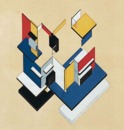
Theo van Doesburg (born Christian Emil Kuepper
[or Küpper]) (Dutch, 1883-1931) and Cornelis van Eesteren
(Dutch), Contra-Construction, an architectural project of 1923, axonometric
projection in gouache
on lithograph
on paper, 22 1/2 x 22 1/2 inches (57.2
x 57.2 cm), Museum of Modern Art, NY. See De Stijl.
 azurite - A mineral used as a blue pigment.
An ore of copper related to malachite
that, when ground up, makes a deep blue pigment with a greenish
tinge. Azurite was an important pigment in ancient
Egypt, often
used for wall paintings. By the Renaissance, it was used for underpainting
the far more costly ultramarine.
azurite - A mineral used as a blue pigment.
An ore of copper related to malachite
that, when ground up, makes a deep blue pigment with a greenish
tinge. Azurite was an important pigment in ancient
Egypt, often
used for wall paintings. By the Renaissance, it was used for underpainting
the far more costly ultramarine.
Related resource:
https://inform.quest/_art